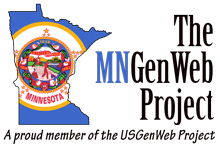

Minnesota Genealogy
Help for County Coordinators
This document is an attempt to give a tutorial in page creation and uploading. It presumes a PC with Windows 3.1, 3.11, or 95; Netscape; WS-FTP; and Rootsweb as server. If your setup differs from these, the instructions may vary as well, but these are the system components I'm familiar with.
Please read the USGenWeb General Help, FAQ and Page Requirements (links below) for details about software, mailing lists, etc. You should also review the USGenWeb policy on copyrights.
Subscribe to the mngen-l mailing list so your state coordinator can communicate with all CCs without having to write to some individually. Just send the command "subscribe" to MNGEN-L-request@rootsweb.com. Be sure to turn off your auto signature when doing so.
You will want to compile all the useful snail mail resources to list that you can find; if you don't live in or near the county you are hosting, and your local public library doesn't have a phone book for it, you may wish to write to the local genealogical society and ask them what addresses they recommend you list for folks researching in that county.
For links, the MNGenWeb/USGenWeb links are in place on some of the orphan pages, although you should feel free to change format, location on page, that sort of stuff. You'll want to do a search on the net for possible pertinent links for your county; try searching as XXX County MN, XXX County Minnesota, XXX County Minnesota Genealogy, and possibly even just XXX Minnesota. If you have any large cities in your county, you may wish to search for them as well.
Now that we have our account and our pages, we want to put them on the web. Start your WS-FTP. You will see a number of blanks.
In profile name, put what you want to call this account; this one's
for your own use.
For host name, put the FTP host that you're uploading to: (for Rootsweb,
users.rootsweb.com)
For type, put the type of server: (for Rootsweb, UNIX(standard))
For userid, put whatever the server gave you to put there:(for Rootsweb,
the userid Brian gave you; usually that's the two letter code for the state
followed by the first six letters of the name of the county.)
For password, whatever password your server gave you.
For account, your account number if you have one. For Rootsweb, either
reuse your userid, or leave it blank, it'll work either way.
For remote host, whatever your server gives you; for Rootsweb, that's
public_html.
For local pc, you want to put the pathway to the directory you keep
your pages in. For example, in my case, that's a directory called c:\htmlstuf
....in this blank I put \htmlstuf. WS-FTP assumes the c: part, and you only
have to enter the drive and colon if it is other than c.
You will want to click "auto save configuration" so that you don't have to
enter this again; and if you click "save password", you won't have to enter
that again, either.
Once you have all the blanks filled in, click the box that says OPEN. (you
have to be online at the time.) WS-FTP will make the connection and you will
see your directory on the left side and the directory of your area on your
server on the right side.
To upload something from the left to the right, either double click on the name of the file to be moved, or single click and then click the arrow pointing to the other page. When it's done, it will come back with a Transfer Complete message in the information box.
Your HTML pages should be loaded as ascii format; your graphics as binary. When you have uploaded everything you need to, click the close box and then the exit box. You can now go to your browser (Netscape or whatever) and enter the URL of your page; it should be visible. (If your county web site is on the Rootsweb server, your address should be http://www.rootsweb.com/~mnxxxxxx where xxxxxx is the first six (or fewer) letters of your county's name).
How often should I do the updates? If at all possible, they should be done within 48 hours of receiving the queries. At the very latest, if there is anything at all to upload or change, you should be doing updates weekly. If there comes a point in time when it appears your county is not being maintained appropriately and in a timely fashion, the state coordinator will contact you regarding the situation. If you fail to respond, you may be relieved of your county coordinator responsibilities and priviledges, and a new coordinator sought to take your place. We are all volunteers with personal lives and sometimes run out of time for volunteer projects, no matter how good our intentions. However, this project is far too important to let county web sites go unattended for any length of time. When you agree to participate in this project, please understand that you are agreeing to update and maintain the county web sites in a timely fashion.
Please see USGenWeb FAQ and read the Basic County Page Requirements and General Help for the USGenWeb Project. These sites will answer just about every question you have about being a county coordinator.
Everton Publishers Review of the Kentucky Project
This page updated for Minnesota on 22 October 1996 by Pat Cotter
and on 26 Oct 1997 by Marge Utley
You are the visitor to this page since October 24, 1996.